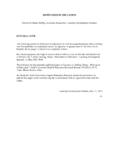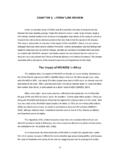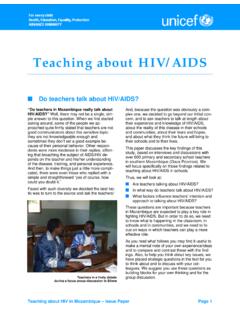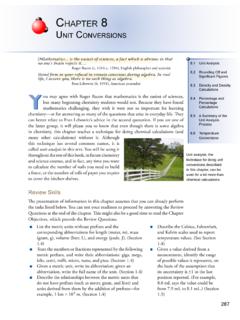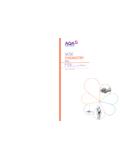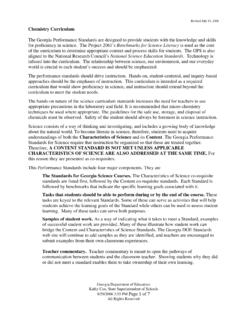Transcription of Atoms, Molecules and Matter: The Stuff of Chemistry
1 Basic Books in ScienceBook 5 Atoms, Molecules and Matter: The Stuff of ChemistryRoy McWeenyBasic Books in Science a Series of books that startat the beginningBook 5 Atoms, Molecules , matter the Stuff of ChemistryRoy McWeenyProfessore Emerito di Chimica Teorica, Universit`a di Pisa, Pisa (Italy)The Series is maintained, with regular updating and improvement, the books may be downloaded entirely free of chargeThis work is licensed under a Creative CommonsAttribution-ShareAlike Unported License(Last updated 10 November 2011)BASIC BOOKS IN SCIENCEA cknowledgementsIn a world increasingly driven by information technology no educational experiment canhope to make a significant impact without effective bridges to the user community thestudents and their the case of Basic Books in Science (for brevity, the Series ), these bridges have beenprovided as a result of the enthusiasm and good will of Dr.
2 David Peat (The Pari Centerfor New Learning), who first offered to host the Series on his website,and of Dr. JanVisser (The Learning Development Institute), who set up a parallel channel for furtherdevelopment of the project. The credit for setting up and maintaining the bridgeheads,and for promoting the project in general, must go entirely to is a global enterprise with no boundaries and, as such, is sure to meet linguisticdifficulties: these will be reduced by providing translations into some of the world s mostwidely used languages. Dr. Angel S. Sanz (Madrid) is preparing Spanish versions of thebooks and his initiative is most warmly appreciate the interest shown by universities in Sub-Saharan Africa ( Universityof the Western Cape and Kenyatta University), where trainee teachers are making useof the Series; and that shown by the Illinois Mathematics and Science Academy (IMSA)where material from the Series is being used in teaching groups of refugee children frommany parts of the who have contributed to the Series in any way are warmly thanked: they have givenfreely of their time and energy for the love of Science.
3 Pisa 10 June 2007 Roy McWeeny (Series Editor)iBASIC BOOKS IN SCIENCEA bout this bookThis book, like the others in the Series1, is written in simple English the language mostwidely used in science and technology. It builds on the foundations laid in Books 1-4,which covered many parts of Mathematics and the approach will be a bit different. In Book 4, we were able to start from simpleobservations about the way things move when they are pushed or pulled; and then tointroduce concepts, like force and mass, and finally to set up lawsof motion for simplesystems consisting of a few point masses or particles . From there we could pass directlyinto the foundations of Physics. But in the present book we re going to be talking aboutparticles so small that nobody can ever even see them. All the things around us, sticks andstones, flesh and bones, and even the air we breathe, are made up fromcountless millionsof such particles.
4 They are calledatomsand when they are put together they give usvarious forms ofmatter: sometimes the atoms stick together in small groups, calledmolecules; or in enormous groups (with the atoms arranged in a repeating pattern),formingcrystalslike salt or ice; sometimes the atoms stay apart and move around at highspeed, as in air and othergases. All these forms of matter are studied inChemistryandthis interpretation of what matter consists of, going back to ancient times, is theatomichypothesisWhen different kinds of matter are put together they mayreact, giving newproducts, inwhich the atoms are differently arranged. Sometimes thereactionisexplosive, sometimesit is slow and gentle, as in cooking food. And in Chemistry we wantto know all about suchreactions. The ancient philosophers didn t have much understanding of all these things:they worked almost entirely by trial and error (sometimes you get it right, sometimes youdon t) and Chemistry started as a purely experimental took many hundredsof years to make sense of everything that happened: but you can start from what weknownow, essentially thatthe atomic hypothesis is true, and you can also make useof what you ve learnt in Mathematics and Physics.
5 That s the way we ll go in Book 5 taking all the short cuts we can find!1 The aims of the Series are described elsewhere, in Book ahead Like Physics, Chemistry is a big subject and you ll need more thanone book; but evenwith only Book 5 you ll be able to lay thefoundationswhich are needed in all parts ofthe subject going from the structure of matter , in terms of atoms and Molecules , tothe way matter can be changed bychemical reactions, to the reactions among gases inthe atmosphere, to those that go on in our bodies (the subject of the Life Sciences, likeBiochemistry and Biology). The part of Chemistry dealt with inthis book is mainly thepart closest to Physics (Physical Chemistry ), so Book 4 has given you many of the basicideas. But what is new is that you can never actuallyseewhat s going on in Chemistryat the deepest level of the atoms themselves. You have toimagineeverything thathappens, starting from the atomic hypothesis and using the laws of Physics to try tointerpretwhat you can see in the s look at some of the main steps you ll take.
6 In Chapter 1 you learn whatatomsare. how small they are (so small that ittakes around 1024of them to fit inside a 1cm cube) and how they can come togetherto makemoleculesand other structures: they are the building blocks of get first ideas about what they are made of: mainlyelectronsandprotons,which have both mass and electric charge , andneutronswhich have only know about mass and force from Book 4, but electric charge will have to waituntil Book 10; it s enough here to know that it s what generates theforcesbetweenparticles that carry a rest of the chapter is about what you can build from the atoms; first moleculesand then matter in bulk , in the forms you know best Chapter 2 builds on the Physics in Book 4, showing that the moving Molecules ina gas must produce apressureon the walls of the container that holds them. If thecontainer isheated, the Molecules move faster and their increasingkinetic energymeasures the hotness of the system.
7 You learn abouttemperature scalesandfind the equation of state (relating temperature (T), pressure (P) and volume (V)for thisideal gas In Chapter 3 we really pass from Physics into Chemistry , by including thether-mal motionof the atoms and Molecules (never even thought about in Book 4!). Inchemical reactions, where Molecules may be breaking up and forming new ones,the thermal energy is constantly changing. The whole system will have aninternalenergy(U), which may be changed by heating it (putting inthermal energyq), or by doingwork(w) on it: the total change will be U=w+qand this istheFirst Law of Thermodynamics. Energy is still never lost: it s just pushedaround from one form into another!This key principle extends the idea of energy conservation (in Book 4) to systems inwhich heat flow takes place; and the nature of the matter itself is changing throughchemical reactions among the Molecules .)
8 You ll find how to dealwith such changes,iidefining standardheats of reaction,heats of formation, and so on, which canbe collected in Tables and used over and over again: this isthermochemistry. Chapter 4 goes deeper than Chapter 2, using the ideas ofprobability theoryto think about thedistributionof molecular speeds in an ideal gas. You ll meet thelaws of Gauss and of Maxwell and find howtemperaturecomes into the picture. In Chapter 5 there are many new ideas: energy is neverlost, but it may bewasted going into forms which can t be used in doing work or boiling water. This isbecause heat always flows downhill from a hotter body to a cooler one, never thereverse. From this simple idea you come to theSecond Law of Thermodynamicsand discover a new quantity, theentropy. Anything that happens by itself isirreversible: it will never run backwards! It must lead toentropy increase; andas far as we can tell this principle holds everywhere in the whole Universe!
9 Here, onEarth, you need it in talking about almost everything to do with heat and energy fromsteam enginestorefrigerators. The next two chapters are aboutunderstandingwhere the laws of thermodynam-ics come from, at the level of the atoms and Molecules . They build on the ideasof order and disorder, the laws of large numbers andprobability. You ll find thatincreasing entropy corresponds simply to increasingdisorderand that all of classi-cal thermodynamics (from the days before much was known about atoms) can bebuilt up from what you know about probabilities. You ll find newbridges betweentheory and experimental Chemistry . And in a final chapter you ll learn how to predict what will happen in simplechemical reactions: whether the reaction will probably go with a bang, with all thereactants used up; or whether it will go only halfway, with a lot of Stuff left over; orwhether it won t go at all!
10 IiiCONTENTSC hapter 1 The structure of Atoms the building blocks of But what are atoms made of? Building The states of 2 Molecules in The ideal gas: a simple Temperature and The equation of stateChapter 3 Chemical Work, Heat, and Energy changes in reactionsChapter 4 A deeper look at the ideal Back to basics: the laws of large Probability Maxwell s distribution What else can we get from Maxwell s law?Chapter 5 The Second When the First Law is not enough what then? Reversible changes: an Some properties of the Some other useful state functionsChapter 6 Statistical interpretation of the Second Order and disorder spontaneous change Will be Sect Reversible changes: an Making contact with But how does thetemperaturecome in? The partition function; another route to Thermodynamic functions: the second routeChapter 7 Partition functions and Getting Finding the PFs: the last Properties of gases and crystalsivChapter 8 Finally back to Chemical Defining the system and its Ideal gas Simple chemical The equilibrium constant.
